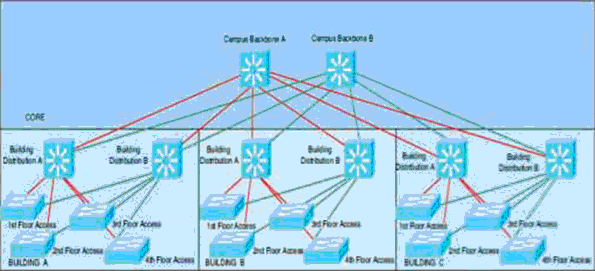
Today's networks typically include voice, video, network management, mission-critical, and routing traffic in addition to bulk user traffic. Each type of traffic has different performance (bandwidth, delay, and jitter) and security requirements.
Network design models provide a framework for integrating many different types of traffic into the network.
Over the years, several models have been used to help describe how a complex network functions. These models are useful for designing a network and for under-standing traffic flow within a more complex network.
There are three models: the traditional Hierarchical Model, the Enterprise Composite Model and the Cisco Enterprise Model.
The Enterprise Network Model is divided into three large sections:
The Enterprise Edge details the connections from the campus to the WAN and includes:
The Service Provider Edge is just a list of the public networks that facilitate wide-area connectivity and includes:
The Campus Architecture component is basically the same as in the Composite model. It includes routing and switching integrated with technologies such as IP telephony and is designed for high availability with redundant links and devices. It integrates security features and provides QoS to ensure application performance. It is flexible enough to add advanced technologies such as VPNs, tunnels and authentication management.
The Data Center component provides a centralized, scalable architecture that enables virtualization, server and application access, load balancing and user services. Redundant data centers might be used to provide backup and business continuity.
The Branch Architecture extends enterprise services to remote offices. Network monitoring and management is centralized. Branch networks include access to enterprise-level services such as converged voice and video, security, and application. Resiliency is obtained through backup local call processing, VPNs, redundant WAN links, and application content caching.
The WAN component provides data, voice and video content to enterprise users any time and any place. QoS, SLA, and encryption ensure a high-quality secure delivery of resources. It uses IPsec or MPLS VPNs over Layer 2 or Layer 3 WANs, with either a hub-and-spoke or mesh topology.


Full range of structured cabling applications that includes planning, design and installation for:
A structured cabling systems means the same cabling systems for Data, voice and video.
Support for multi-vendor equipmentA standard-based cable system will support applications and hardware even with mix & match vendors.
Simplify moves/adds/changesStructured cabling systems can support any changes within the systems.
With structured cabling systems, problems are less likely to down the entire network, easier to isolate and easier to fix.
Support for future applicationsStructured cabling system supports future applications like multimedia, video conferencing etc. with little or no upgrade pain.

Vision Tech is a leading systems integration, technology services and consulting company. It was founded with the belief: